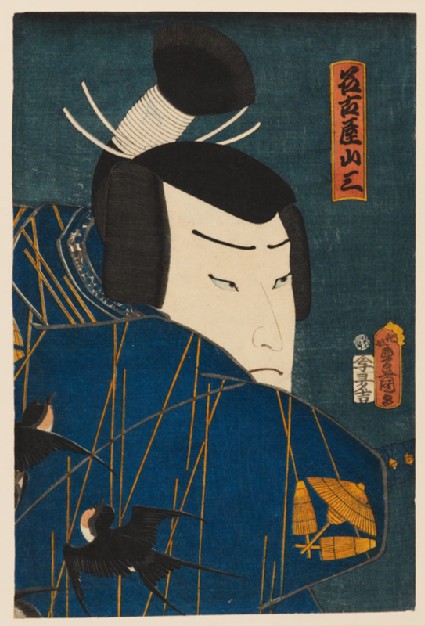Browse: 10610 objects
An actor in the role of the samurai Nagoya Sanza
-
Description
‘Large head’ pictures (ōkubi-e), showing just the head and shoulders of the subject rather than the whole body, became popular after the 1780s. Ōkubi-e allowed the print designer to emphasize particular facial features, expressions or make-up of the actor depicted.
Depiction of costumes also formed an essential feature of actor prints. Motifs and patterns on costumes often emphasize the emotions of a role, or reflect in some way the content of the play. The dashing young samurai depicted here is easily identified by his kimono, which is decorated with a distinctive pattern of swallows in the rain.
-
Details
- Series
- Ukiyo's Sword Hilt, a Double Grave Mound and the Mark of the Lightning Bolt
- Associated place
- Date
- designed 1860
- Artist/maker
-
Utagawa Kunisada (1823-1880) (designer)
- Associated people
-
Ōtaya Takichi (active c. 1848 - 1867) (publisher)
- Material and technique
- woodblock
- Dimensions
-
mount 55.6 x 40.6 cm (height x width)
print 36 x 24 cm (height x width)
- Material index
- Technique index
- Object type index
- No. of items
- 1
- Credit line
- Presented by Mrs Allan and Mr and Mrs H. N. Spalding, 1952.
- Accession no.
- EAX.4211
Glossary
kimono
-
kimono
Kimonos, or 'the thing worn' in Japanese, had seasonal designs. The style of kimonos would change four times a year, and winter kimonos would be padded.
Past Exhibition
see (1)Location
-
- currently in research collection
Objects are sometimes moved to a different location. Our object location data is usually updated on a monthly basis. Contact the Jameel Study Centre if you are planning to visit the museum to see a particular object on display, or would like to arrange an appointment to see an object in our reserve collections.
© 2013 University of Oxford - Ashmolean Museum


